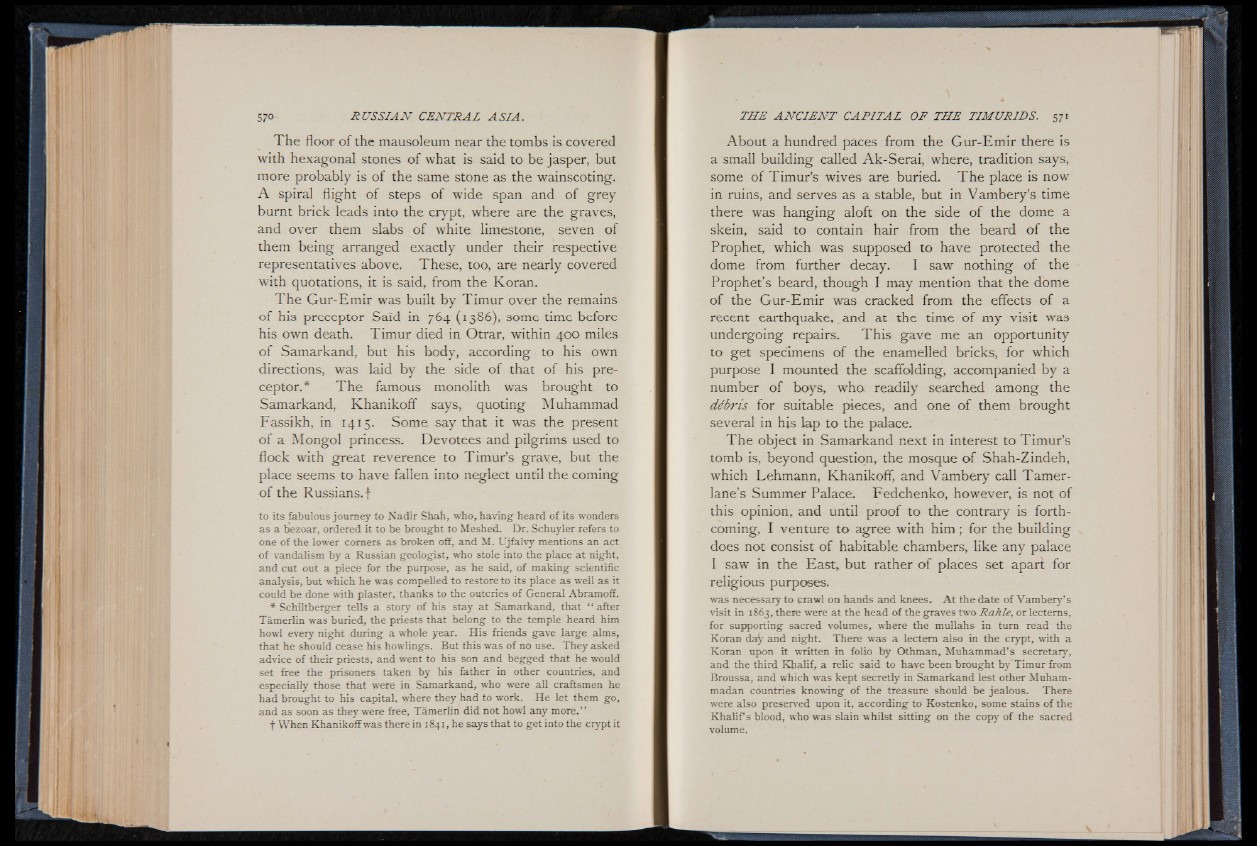
The floor of the mausoleum near the tombs is covered
with hexagonal stones of what is said to be jasper, but
more probably is of the same stone as the wainscoting.
A spiral flight of steps of wide span and of grey
burnt brick leads into the crypt, where are the graves,
and over them slabs of white limestone, seven of
them being arranged exactly under their respective
representatives above. These, too, are nearly covered
with quotations, it is said, from the Koran.
T he Gur-Emir was built by Timur over the remains
of his preceptor Said in 764 (1386), some time before
his own death. Timur died in Otrar, within 400 miles
of Samarkand, but his body, according to his own
directions, was laid by the side of that of his preceptor.*
T h e famous monolith was brought to
Samarkand, Khanikoff says, quoting Muhammad
Fassikh, in 1415. Some say that it was the present
of a Mongol princess. Devotees and pilgrims used to
flock with great reverence to Timur’s grave, but the
place seems to have fallen into neglect until the coming
of the Russians, f
to its fabulous journey to Nadir Shah, who, having' heard of its wonders
as a bezoar, ordered it to be brought to Meshed. Dr. Schuyler refers to
one of the lower comers as broken off, and M. Ujfalvy mentions an act
o f vandalism by a Russian geologist, who stole into the place at night,
and cut out a piece for the purpose, as he said, of making scientific
analysis, but which he was compelled to restore to its place as well as it
could be done with plaster, thanks to the outcries of General Abramoff.
* Schiltberger tells a story of his stay at Samarkand, that “ after
Tamerlin was buried, the priests that belong to the temple heard him
howl every night during a whole year. His friends gave large alms,
that he should cease his howlings. But this w as of no use. They asked
advice o f their priests, and went to his son and begged that he would
set free the prisoners taken by his father in other countries, and
especially those that were in Samarkand, who were all craftsmen he
had brought to his capital, where they had to work. He let them go,
and as soon as they were free, Tamerlin did not howl any more.”
t When Khanikoff was there in 1841, he says that to ge t into the crypt it
About a hundred paces from the Gur-Emir there is
a small building called Ak-Serai, where, tradition says,
some of Timur’s wives are buried. The place is now
in ruins, and serves as a stable, but in Vambery’s time
there was hanging aloft on the side of the dome a
skein, said to contain hair from the beard of the
Prophet, which was supposed to have protected the
dome from further decay. I saw nothing of the
Prophet’s beard, though I may mention that the dome
of the Gur-Emir was cracked from the effects of a
recent earthquake, and at the time of my visit was
undergoing repairs. This gave me an opportunity
to get spécimens of the enamelled bricks, for which
purpose I mounted the scaffolding, accompanied by a
number of boys, who readily searched among the
débris for suitable pieces, and one of them brought
several in his lap to the palace.
The object in Samarkand next in interest to Timur’s
tomb is, beyond question, the mosque of Shah-Zindeh,
which Lehmann, Khanikoff, and Vambery call Tamerlane’s
Summer Palace. Fedchenko, however, is not of
this opinion, and until proof to the contrary is forthcoming,
I venture to agree with him ; for the building
does not consist of habitable chambers, like any palace
I saw in the East, but rather o f places set apart for
religious purposes.
was necessary to crawl on hands and knees. A t the date of Vambery’ s
visit in 1863, there were at the head of the graves two Rahle, or lecterns,
for supporting sacred volumes, where the mullahs in turn read the
Koran day and night. There was a lectem also in the crypt, with a
Koran upon it written in folio by Othman, Muhammad’ s secretary,
and the third Khalif, a relic said to have been brought by Timur from
Broussa, and which was kept secretly in Samarkand lest other Muhammadan
countries knowing of the treasure should be jealous. There
were also preserved upon it, according to Kostenko, some stains of the
K h a lif s blood, who was slain whilst sitting on the copy of the sacred
volume.